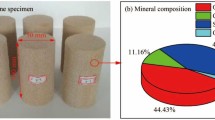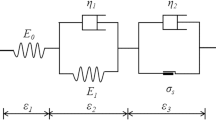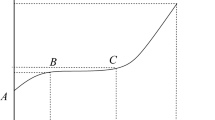Abstract
The rock masses of hydro-fluctuation belt experience seepage pressure following impoundment in the Three Gorges Reservoir; its creep behaviors are significant for reservoir bank slopes. To study the creep behaviors under seepage pressure (0, 1.45, and 1.75 MPa), we performed creep tests using representative landslide sandstone in the Three Gorges Reservoir and investigated the sandstone creep behaviors under the coupling effects of seepage pressure and stress. Previous researches on rocks have usually regarded the creep constitutive parameter as a constant; however, in this study, a nonlinear, nonstationary, plastic-viscous (NNPV) creep model which can describe the curve of sandstone creep tests is proposed. The rock-creep parameters under three levels of seepage pressure were identified, and theoretical curves using the NNPV model agreed well with the experimental data, indicating that the new model cannot only describe the primary creep and secondary creep stages under varying seepage pressures but also, in particular, perfectly describes the tertiary creep stage. Finally, the sensitivity of the NNPV model parameters is analyzed, and the result shows that the nonstationary coefficient α and the nonlinear coefficient m are main parameters affecting the tertiary creep stage.










Similar content being viewed by others
References
Aydan O, Ito T, Ozbay U, Kwasniewski M, Shariar K, Okuno T, Ozgenoglu A, Malan DF, Okada T (2014) ISRM suggested methods for determining the creep characteristics of rock. Rock Mech Rock Eng 47(1):275–290
Barla G, Debernardi D, Sterpi D (2012) Time-dependent modeling of tunnels in squeezing conditions. ASCE Int J Geomech 12(6):697–710
Bell A, Naylor M, Heap M, Main I (2011) Forecasting volcanic eruptions and other material failure phenomena: An evaluation of the failure forecast method. Geophys Res Lett 38:L15304
Boukharov GN, Chanda MW, Boukharov NG (1995) The three processes of brittle crystalline rock creep. Int J Rock Mech Min Sci Geomech Abstr 32(4):325–335
Bozzano F, Martino S, Montagna A (2012) A back analysis of a rock landslide to infer rheological parameters. Eng Geol 131–132:45–56
Brantut N, Heap MJ, Baud P, Meredith PG (2014) Rate-and strain-dependent brittle deformation of rocks. J Geophys Res Solid Earth 119(3):1818–1836
Chen L, Wang CP, Liu JF (2014) A damage-mechanism-based creep model considering temperature effect in granite. Mech Res Commun 56:76–82
Crosta GB, di Prisco C, Frattini P, Frigerio G, Castellanza R, Agliardi F (2014) Chasing a complete understanding of the triggering mechanisms of a large rapidly evolving rockslide. Landslides 5:747–764
Debernardi D, Barla G (2009) New viscoplastic model for design analysis of tunnels in squeezing conditions. Rock Mech Rock Eng 42(2):259–288
Fabre G, Pellet F (2006) Creep and time-dependent damage in argillaceous rocks. Int J Rock Mech Min Sci 43(6):950–960
Furuya G, Sassa K, Hiura H, Fukuoka H (1999) Mechanism of creep movement caused by landslide activity and underground erosion in crystalline schist, Shikoku Island, southwestern Japan. Eng Geol 53:311–325
Gilles A, Nathalie C, Jean T, Darius MS (2017) Fundamental aspects of the hydromechanical behaviour of Callovo-Oxfordian claystone: from experimental studies to model calibration and validation. Comput Geotech 85:277–286
Haller AD, Hobbs M, Spangenberg JE (2016) Adapting the diffusive exchange method for stable isotope analysis of pore water to brine-saturated rocks. Chem Geol 444:37–48
Hao SW, Zhang BJ, Tian JF, Elsworth D (2014) Predicting time-to-failure in rock extrapolated from secondary creep. J Geophys Res Solid Earth 119(3):1942–1953
Heap MJ, Baud P, Meredith PG (2009b) Influence of temperature on brittle creep in sandstones. Geophys Res Lett 36:L19305
Heap MJ, Baud P, Meredith PG, Bell AF, Main IG (2009a) Time dependent brittle creep in Darley dale sandstone. J Geophys Res 114:B07203
Hendron AJ, Patton FD (1987) The vaiont slide-a geotechnical analysis based on new geologic observations of the failure surface. Eng Geol 24:475–491
Palmer J (2017) Creeping earth could hold secret to deadly landslides. Nature 548:384. https://doi.org/10.1038/548384a
Jarman D, Calvet M, Corominas J, Delmas M, Gunnel Y (2014) Large-scale rock slope failures in the eastern Pyrenees: identifying a sparse but significant population in paraglacial and parafluvial contexts. Glacial Paraglacial Environ 96:357–391
Jia SP, Wang Q, Chen WZ (2011) Study on the hydro-mechanical-damage coupled model of boom clay during tunnel excavation and construction. Mater Res Innov 15(s1):517–521
Jiang QH, Qi YJ, Wang ZJ, Zhou CB (2013) An extended Nishihara model for the description of three stages of sandstone creep. Geophys J Int 193:841–854
Klimes J, Yepes J, Becerril L (2016) Development and recent activity of the San Andres landslide on el Hierro, Canary Islands. Spain Geomorphol 261:119–131
Liu L, Xu WY, Wang HL, Wang RB (2016) Permeability evolution of granite gneiss during Triaxial creep tests. Rock Mech Rock Eng 49(9):3455–3462
Lockner DA (1993) The role of acoustic emission in the study of rock fracture. Int J Rock Mech Min Sci Geomech Abstr 30(7):883–899
Main IG (2000) A damage mechanics model for power-law creep and earthquake aftershock and foreshock sequences. Geophys J Int 142:151–161
Sun M, Tang H, Wang M, Shan Z, Hu X (2016) Creep behavior of slip zone soil of the Majiagou landslide in the three gorges area. Environ Earth Sci 75(16):1199
Meng QB, Zhang MW, Han LJ, Pu H, Chen YL (2017) Acoustic emission characteristics of red sandstone specimens under uniaxial cyclic loading and unloading compression. Rock Mech Rock Eng. https://doi.org/10.1007/s00603-017-1389-6
Nedjar B, Le Roy R (2013) An approach to the modeling of viscoelastic damage. Application to the long-term creep of gypsum rock materials. Int J Numer Anal Met 37(9):1066–1078
Ngwenya BT, Main IG, Elphick SC, Crawford BR, Smart BGD (2001) A constitutive law for low-temperature creep of water-saturated sandstones. J Geophys Res 106:21811–21826
Nishihara M (1952) Creep of shale and sandy-shale. J Geol Soc Jpn 58:373–377
Nomikos P, Rahmannejad R, Sofianos A (2011) Supported axisymmetric tunnels within linear viscoelastic burgers rocks. Rock Mech Rock Eng 44(5):553–564
Oda M (1986) An equivalent continuum model for coupled stress and fluid flow analysis in jointed rock masses. Water Resour Res 22(13):1845–1856
Pirulli M, Colombo A, Scavia C (2011) From back-analysis to run-out prediction: a case study in the western Italian alps. Landslides 8(2):159–170
Rutter EH, Green S (2011) Quantifying creep behaviour of claybearing rocks below the critical stress state for rapid failure:Mam tor landslide, Derbyshire, England. J Geol Soc Lond 168:359–372
Schmidtke RH, Lajtai EZ (1985) The long-term strength of lac du bonnet granite. Int J Rock Mech Min Sci 22(6):461–465
Shao JF, Zhu QZ, Su K (2003) Modeling of creep in rock materials in terms of material degradation. Comput Geotech 30:549–555
Sterpi D, Gioda G (2009) Visco-plastic behaviour around advancing tunnels in squeezing rock. Rock Mech Rock Eng 42(2):319–339
Tang CA, Tham LG, Lee PKK, Yang TH, Li LC (2002) Coupled analysis of flow, stress and damage (FSD) in rock failure. Int J Rock Mech Min Sci 39(1):477–489
Voight B (1988) A method for prediction of volcanic eruptions. Nature 332:125–130
Wang XG, Hu B, Hu XL, Tang HM, Wang JD, Huang L (2016) A constitutive model of granite shear creep under moisture. J Earth Sci 27(4):677–685
Wang XG, Wang JD, Gu TF (2017) A modified Hoek-Brown failure criterion considering the damage to reservoir bank slope rocks under water saturation-dehydration circulation. J Mt Sci 14(4):771–781
Wu LZ, Li B, Huang RQ, Sun P (2017) Experimental study and modeling of shear rheology in sandstone with non-persistent joints. Eng Geol 222:201–211
Xu WY, Wang RB, Wang W, Zhang ZL, Zhang JC, Wang WY (2012) Creep properties and permeability evolution in triaxial rheological tests of hard rock in dam foundation. J Cent South Univ 19:252–261
Yang TH, Xu T, Liu HY (2013a) Rheological characteristics of weak rock mass and effects on the long-term stability of slopes. Rock Mech Rock Eng 47(6):2253–2263
Yang WD, Zhang QY, Li SC, Wang SG (2013b) Time-dependent behavior of diabase and a nonlinear creep model. Rock Mech Rock Eng 47:1211–1224
Yuan SC, Harrison JP (2005) Development of a hydro-mechanical local degradation approach and its application to modelling fluid flow during progressive fracturing of heterogeneous rocks. Int J Rock Mech Min Sci 42:961–984
Zhou HW, Wang CP, Han BB (2011) A creep constitutive model for salt rock based on fractional derivatives. Int J Rock Mech Min Sci 48(1):116–121
Zhou ZL, Cai X, Zhao Y, Chen L, Xiong C, Li XB (2016) Strength characteristics of dry and saturated rock at different strain rates. Trans Nonferrous Met Soc Chin 26:1919–1925
Funding
These research results are supported by the National Natural Science Foundation of China (No. 41630639), the China Postdoctoral Science Foundation (2016M602743), Scientific Research Program Funded by Shaanxi Provincial Education Department (No. 16JK1766), Postdoctoral scientific research project in Shaanxi province (2016).
Author information
Authors and Affiliations
Corresponding author
Appendix 1
Appendix 1
One-dimensional creep constitutive equations of the NNPV
-
(1)
When σ0 ≤ σs, the NNPV elements satisfy the following conditions
where σ is the total stress and ε is the total strain.
-
(2)
When σ0 ≥ σs and t ≤ tP, the NNPV elements satisfy the following conditions:
-
(3)
When σ0 ≥ σs and t ≥ tP, let \( {\left(\frac{t-{t}_P}{t_0}\right)}^m=A \), and the NNPV elements satisfy the following conditions:
In the tests, σ = σ0 = constant and the initial conditions of stress strain are:
Based on Eqs. (10)–(13), and with Laplace and Laplace inverse transformation, then:
-
(a)
When σ0 ≤ σs, the NNPV creep equation is Eq. (4),
-
(b)
When σ0 ≥ σs and t ≤ tP, the NNPV creep equation is Eq. (5),
-
(c)
When σ0 ≥ σs and t ≥ tP, the NNPV creep equation is Eq. (6).
Three-dimensional creep constitutive equations of the NNPV
In the 3D stress state, the rock stress tensor σij can be decomposed into spherical tensor σm and partial tensor Sij; the strain tensor can be decomposed into spherical strain tensor εm and partial strain tensor eij, then:
δij is Kronecker’s sign, σm only changes the volume of an object, but not shape, and Sijonly only changes the shape, but not volume. Thus, strain tensor can also be separated into spherical strain tensor εm and partial strain tensor eij, then:
Let rock shear module be G, volume module be K, elastic module be E, and Poisson’s ratio be μ, then:
In the 3D stress state, based on Hooke’s law (Wang et al. 2016), then:
Based on Eqs. (4), (15), and (16), when the constant deviator stress (Sij)0 is smaller than the rock yield strength σs, the 3D creep equation is expressed as:
where G1 , G2, and G3 are the shear elastic module corresponding to E1 , E2, and E3 in NNPV.
In the 3D stress state, when (Sij)0 ≥ σs and t ≤ tP, rock plastic deformation occurs; rock yield surface F and plastic potential function Q should be introduced (Yang et al. 2013b), then: viscoplastic deformation rate as the fourth part in NNPV model is:
where f is yield function; f=Q when relevant flow rules are used, then the 3D constitutive equation in the fourth part of NNPV model is:
Yield function f can be expressed as (Jiang et al. 2013):
where J2 is the second stress deviator invariant.
Based on Eqs. (18) and (22), when (Sij)0 ≥ σs and t ≤ tP, the constitutive equation of the NNPV model under 3D stress is:
Similarly, in the 3D stress state, when (Sij)0 ≥ σs and t ≥ tP, the constitutive equation of NNPV model under 3D stress is expressed as:
The triaxial compression creep stress state is σ2 = σ3 and constant; all levels of loads σ1 after loading are constant; then from Eqs. (18), (23), and (24):
Rights and permissions
About this article
Cite this article
Wang, X., Yin, Y., Wang, J. et al. A nonstationary parameter model for the sandstone creep tests. Landslides 15, 1377–1389 (2018). https://doi.org/10.1007/s10346-018-0961-9
Received:
Accepted:
Published:
Issue Date:
DOI: https://doi.org/10.1007/s10346-018-0961-9




